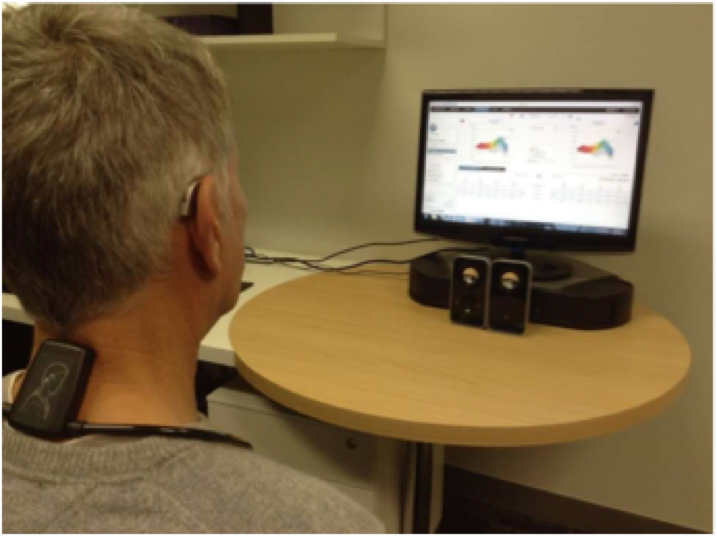The Oxford dictionary definition of hearing aid verification is the process of establishing the truth, accuracy or validity of something.
The Australian Commonwealth Hearing Services Program (HSP) definition is: an objective method to demonstrate the device fitting is appropriate and supports the client to manage their hearing loss.
Verification means the hearing aid is fit for purpose. It provides both audibility and intelligibility of speech. Leading brand Widex describe that “it’s not about matching lines or meeting targets.”
Probe Tube Real Ear Measurements
Long used methods of verification have involved Real Ear Measurements or (REM’s) using a probe tube microphone to measure hearing aid output in-situ or in the ear canal close to the ear drum.

Method 1: Real Ear Insertion Gain (REIG)
One Method is measuring Real Ear Insertion Gain (REIG). These measure the sound pressure level (SPL) near the ear drum. It subtracts the SPL at a reference point outside the head. The SPL picked up by the external reference microphone.
There are some drawbacks of this type of measurement as follows:
- They require stable probe tube placement with and without the hearing aid in the ear.
- Does not take into account the ear canal acoustics, because REUG is subtracted.
- Takes account of the gain provided but NOT the effect of the device features
- They measure aid response in the ear canal.
Method 2: Aided Output (REAR)
- Only needs one trace with a stable probe tube placement and the device in the ear.
- Takes account of the ear canal acoustics.
- Takes account of the gain provided with all features activated.
- Measures aided response in the real world.
Hearing Aid Verification Using Speech Mapping
Speech Mapping applies generic “Speech-o-gram” targets for 65dB speech inputs. It uses a long term average speech spectrum (LTAS).
The preferred test signal is a shaped speech-like signal. This is because today’s hearing aids are designed to identify speech and remove noise.
The prescriptive gain targets are based on national acoustic laboratories targets instead of the proprietary formulae of the hearing aids manufacturer.
Potential Errors with Real Ear Measurements
- The choice of formula (NAL or manufacturer) is now less important.
- It is more important to measure overall aid function in the real world
- NAL implementation by the hearing aid manufacturer is in question.
- The NAL implementation by the REM equipment manufacturer is in question.
- Probe tube placement remains an on-going challenge in the clinic
New Probe Tube Free Speech Mapping
Widex have proposed a new method of hearing aids verification known as probe tube free speech mapping. This is a software based tool that generates output spectrum for continuous input signals. This is based on a statistical analysis of all sounds including pauses with no sound.
It is used with an externally calibrated International Speech Test Signal (ISTS). This generates a realistic and accurate representation of the speech spectrum. This is based either on Widex proprietary formulae or NAL NL2 probe tube placement.
Advantages of Speech Mapping
This method of hearing aid verification eliminates the errors of measurement associated with the manufacturer implementations of NAL NL2.
It eliminates errors due to inaccurate probe tube placement.
Based on a speech detector algorithm. This differentiates voiced and unvoiced speech inputs to enable real time speech analysis in situ.
The speech detector algorithm provides an accurate and independent representation of both “voiced” and “voiceless” speech.
For Example: important, not impordant.It actively identifies voice components, unlike most systems which focus on identifying and removing noise
The speech detector algorithm works in real time, ensure continuous identification of the ISTS signal during the verification process
Real Time Validation
The speech detector algorithm implemented in the software is also used to validate the fitting and counsel clients.
Live voice (clinician or partner) can be used to evaluate client benefit in quiet and noise for soft, average or loud inputs
Features such as expansion or compression can be demonstrated to clients and fine- tuned for comfort and audibility

Benefits of Speech Mapping to the Clinician & Client
Speech tracker is faster to perform and changes can be made to the aid whilst the test is being conducted. Faster then REM’s.
Wax in the ear canal is not an issue, which saves time and money on probe tubes.
It is more flexible than meeting an exact target. I just need to show the black line is above the audiometric threshold.
I only need to have one Noah file open which makes the aid set up easier because I don’t need to chop and change between programs”
Makes it easier for the Clinician to explain the results to the client because it is readily translatable to everyday life and meeting COSI goals
We like to show how the aids respond with loud/soft speech. It is easy to play sound files from the software to demonstrate how the aids work.
